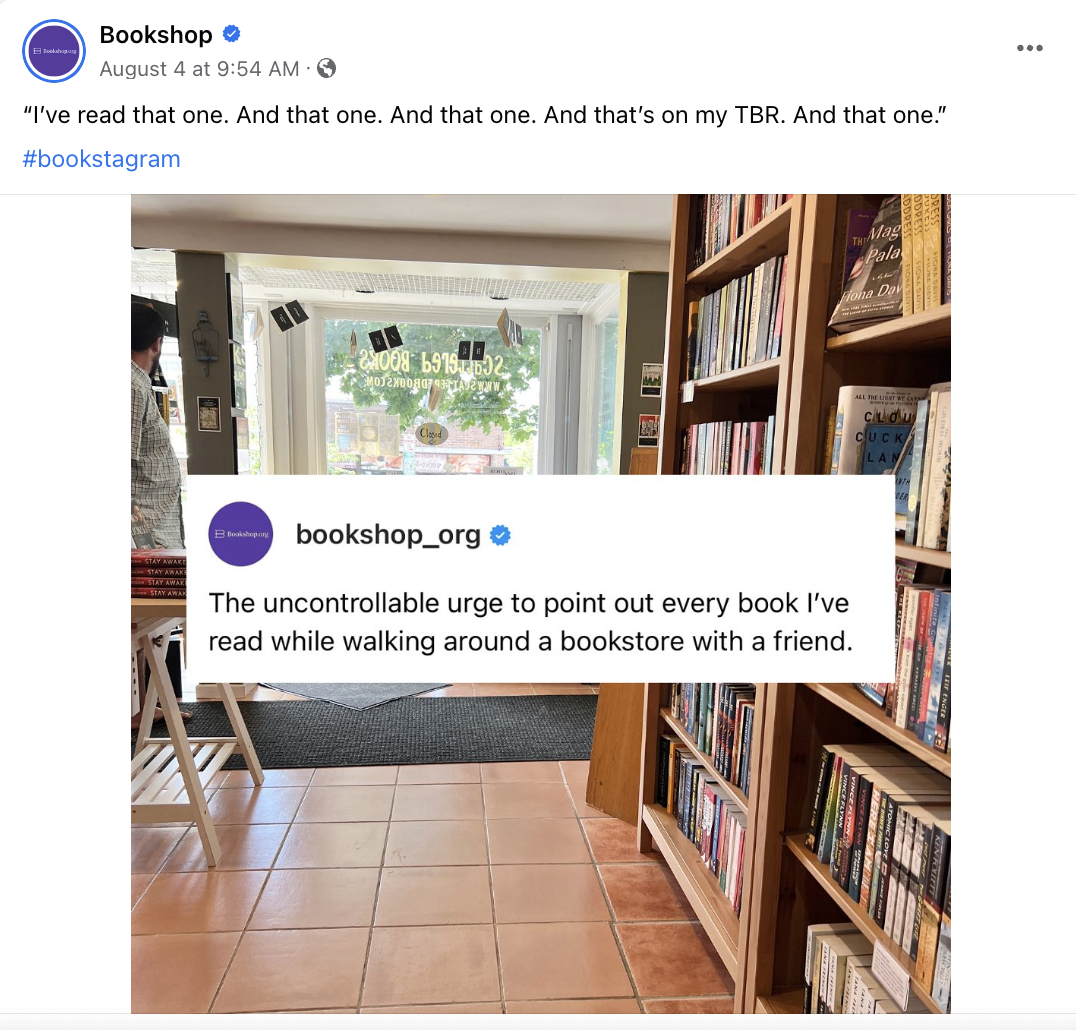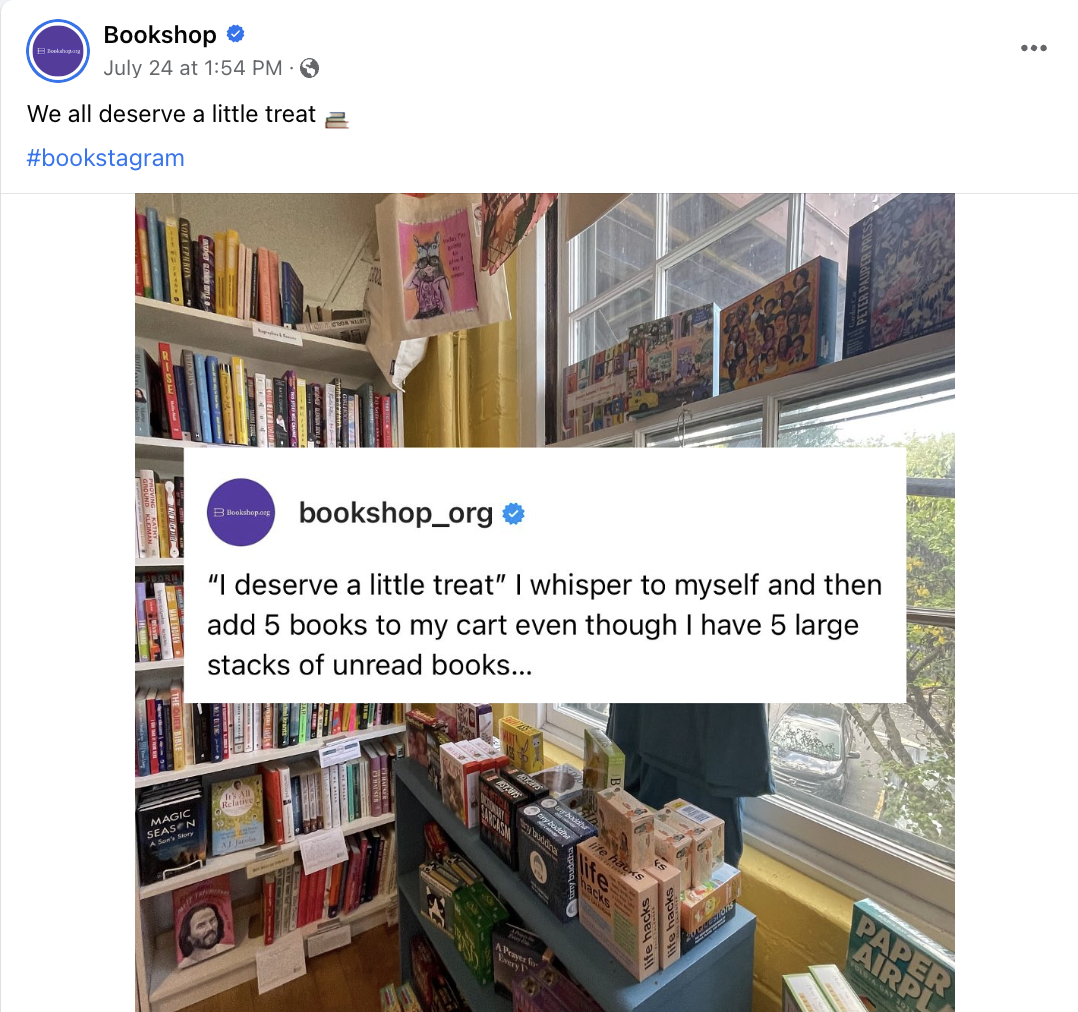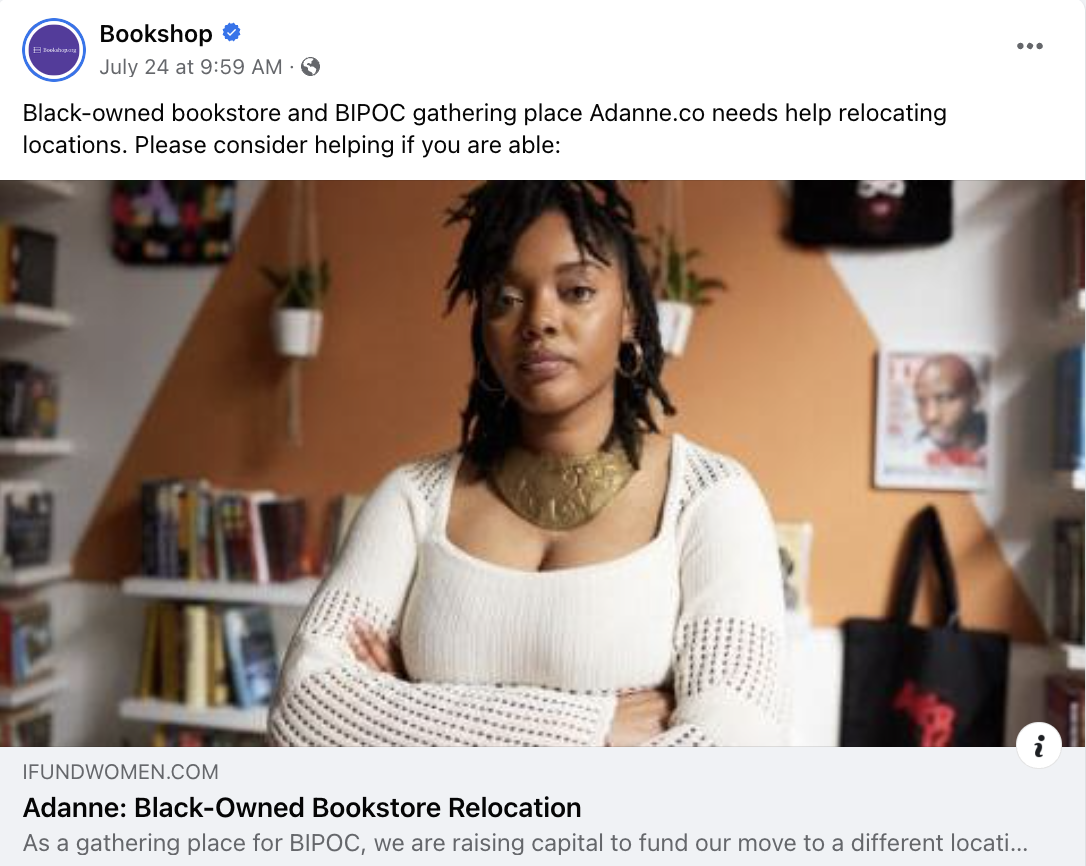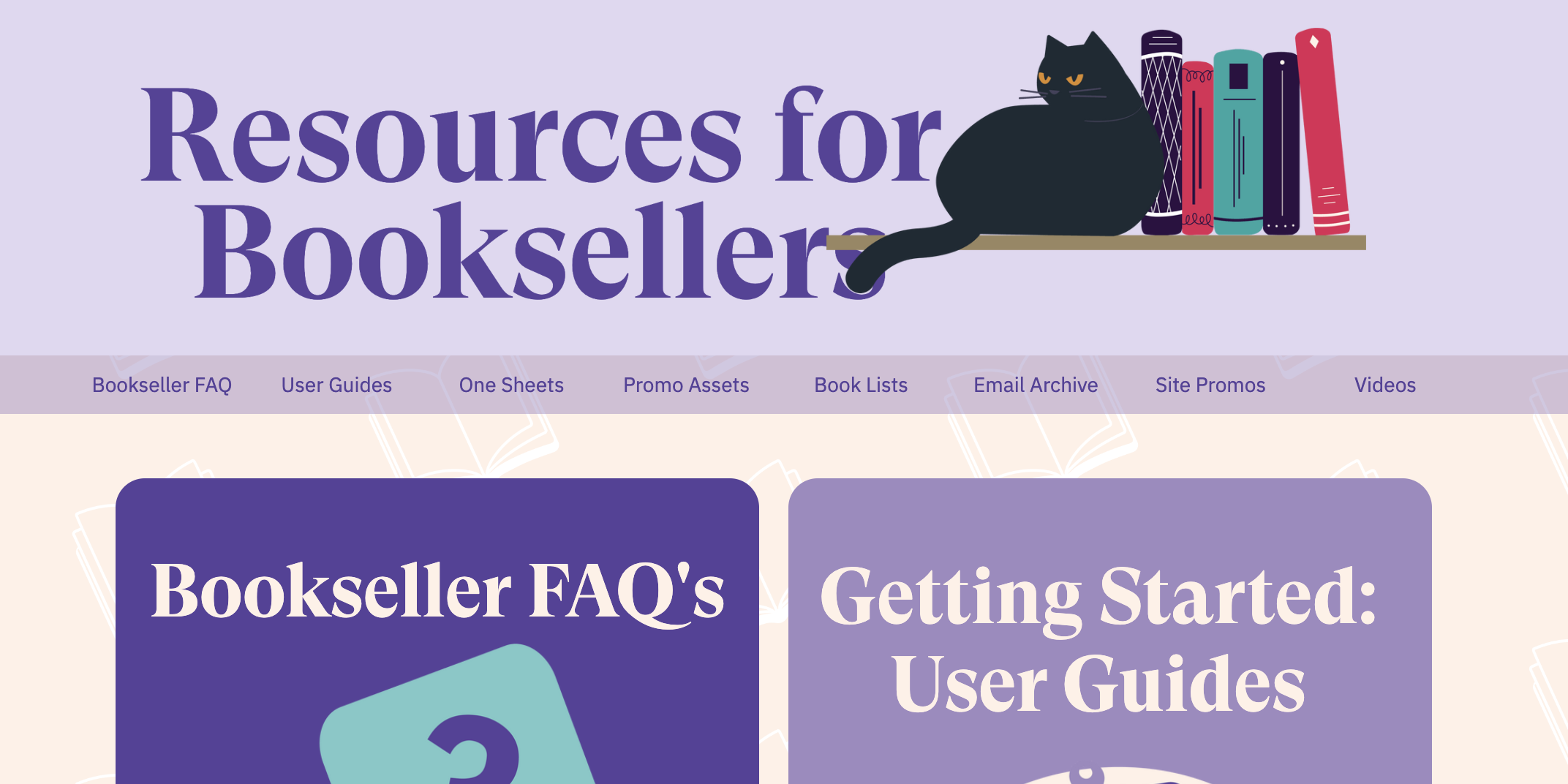This essay originally was published on August 17, 2023, with the email subject line "CT No. 180: The community-charged brand voice challenging Amazon's bookselling dominance."
If you’re not a super book nerd like me, you might not know about Bookshop.org. The site launched as an alternative marketplace for readers to support independent bookstores in January 2020 — which, unlike other industries, turned out to be a boon for online book sales.
Bookshop’s networked affiliate structure lets authors, publishers, and even reviewers earn commissions.* Because of that model, Bookshop has multiple, overlapping audiences: the direct consumer (like me) as well as publishers, bookstores, and authors.
Despite the different reasons these groups may visit Bookshop, most, if not all, likely share a love of books and care about the literary community — and that’s by design. Bookshop is a direct response to Amazon, which has taken a sizable chunk of book sales over the past 20 years, leaving independently owned bookstores in a lurch. But the success of the site has demonstrated that Amazon’s less friendly verticalization model isn’t the only compelling sales strategy on the block, and it may be one that an increasing number of consumers want to avoid.
With literary community at its core, Bookshop helps indie booksellers thrive in a world where small businesses’ odds of success are bleak. It supports authors and reviewers who want to grow their audience, and small press publishers who want their books distributed across the world. Most importantly, it provides consumers with a means to purchase a wide array of books in varying formats (paperback, hardcover, digital disk, etc.) from local bookstores — not in spite of them.
Translating these values into a voice that conveys their authenticity isn’t simple, especially because approachability is crucial to Bookshop’s brand. In addition to being a marketplace with plural functions and audiences, it’s also a community hub where everyone from the extremely bookish to one-time gift shoppers must feel welcome. But Bookshop pulls it off, and the brand approach the company uses to win over its patrons are worth our consideration.
*Full disclosure: The Content Technologist has long had a Bookshop.org affiliate page to house our occasional reading recommendations.
Making a mark for the bookselling industry
Sidestepping the usual promises of market disruption, Bookshop has deliberately positioned itself as an industry reinforcer and supporter. But without considerable help from the pandemic reading boom, its success may not have been foreordained. Post-shutdown, it proved that the experience it creates online is a value to customers and indie bookstores alike. And, as CEO Andy Hunter shared with TechCrunch, Bookshop recognizes it has to create the human experience shoppers associate with bookstores. For the site, this means creating “a platform that is extremely compelling to customers, that does everything that booksellers want us to do.”
Bookshop incorporates this community-first mentality into how they communicate with their audience at every touchpoint. The site itself is designed to be bookseller-friendly, and indies can even create their own digital storefronts, or just use Bookshop’s affiliate linking system.
With its affiliate program, the book distributor revives a relatively old-fashioned, search-optimizing web strategy. That strategy effectively creates cross-linking networks which cross-pollinate audiences instead of competing for search presence. Because search engines recognize when authoritative websites are linking to other similarly expert websites, they give those sites priority. It’s a rising-tide-lifts-all-digital-storefront situation, necessary to battle Amazon’s near-monopolistic digital dominance.
Meanwhile, the language and phrases Bookshop uses in their promotional materials draws directly from how book nerds talk nerdishly about books, using the colloquialisms of the audience with ease rather than the force “cringe” you sometimes see among brands who don’t really know their audience but want to sound like they do. This alignment between voice and messaging can really make or break a brand experience.


Consistently cute, but never cringe: Bookshop's brand voice in social media.
Need proof that this strategy works? Earlier this year the American Booksellers Association (ABA) announced it was shifting from IndieBound to Bookshop for online sales fulfillment, saying that the move “will help eliminate consumer confusion, improve data for the indie channel, convert more consumers, generate more revenue for booksellers (thanks to a simpler purchase flow and higher conversion rate), and optimize the impact of Bookshop.org for independent bookstores.” Not bad for a company that launched three years ago.
A name that says it all
For many consumers, the first interaction with a brand is their name and a visual identity. In addition to being a concise image that clarifies the site’s function, Bookshop.org makes it clear who and what the book distributor is about. The company’s strategic decision to include “.org” — usually associated with nonprofits and other goodwill organizations — in their trade name probably helped them clear some trademarking hurdles. But it also signals the Bookshop consumer experience is one grounded in giving back (as .org implies). The domain extension brand element might be an overlooked detail for some, but remember: Bookshop’s customer base are readers. They’re looking for clear communication, even in the fine print.
Adding to this recognizable name, Bookshop has been certified as a benefit corporation (or B corp) since March 2022 — a process that elevates their name and puts them among a consortium of similarly progress-driven organizations across the world. By meeting the B corporation standards, Bookshop produced yet another layer of branding alignment within its mission, and earned further legitimacy in the eyes of eco-conscious consumers, especially those who may be hearing about the company and its values for the first time.
A perspective shaped by data
When it comes to Bookshop’s website, there’s not a lot of space made for brand voice. The site is focused almost exclusively on book sales and helping customers find the books they need. Yet there is also always a compelling reminder of their mission on prominent display. Just underneath the menu items near the top of the page, a counter widget keeps track of how much money Bookshop has put into the hands of indie bookstores.

At first glance, the widget is a pretty straightforward appeal — one you could note and then ignore. But the code snippet is persistent through the entire online shopping experience, and it's difficult to not notice it each time you head to Bookshop.org. This putting-your-money-where-your-mouth-is gesture demonstrates how a simple, concise data point can shape an entire user journey. (Again, it’s worth noting that Bookshop has a strong focus on first-time shoppers.)
As consumers (or even partner organizations and the indies with storefront on the site), we can see the real-time effect of buying books from Bookshop instead of other, less community-driven online retailers. With a single numerical figure, the company builds a connection between its patrons and the local stores they’re helping support. It's a simple reminder that our clicks and purchases are meaningful actions that contribute to a bigger goal, and that even small steps towards self-empowerment can create a better ecosystem for small businesses.

Satisfying needs, representing values
For ease of use, Bookshop keeps its user interface clean and streamlined. Signing up is simple and meets the needs of their bookstore audience by not taking too much time away from their primary task of running the store. They meet their users where they are and make the process simple with an easy- to-understand overview of the process and then a simple form to complete. This might seem more like UI design than voice, but it shows how the two work best when they work together to create a seamless experience for their end user.
A surprising favorite for me is Bookshop's use of FAQs. Offering the questions real people have clearly asked with responses that actually provide value. Often FAQ pages feel like the space where instructions go to die. For Bookshop, this lighthearted page instead offers guidance to patrons, bookstore owners, and even indie authors. Perhaps the most emblematic of these resources is the company’s affiliate sign-up guide, which is illustrated, concise, and easy to share.

How Bookshop changed me
Since becoming more informed about the immense challenge independent booksellers face, my awareness about my purchasing habits has evolved. I live in a city of indie bookstores, but they often don’t have the specific books I want. I once had no qualms buying on Amazon, especially after I had done my due diligence in checking the local stores. But now, with the little nudges and reminders that I get as a regular follower and subscriber of Bookshop, I am one of the 78 percent of customers who switched to the service after regularly buying from Amazon.
Today, I look up my favorite local bookstore and place my order, relieving some of my Amazon guilt. At the same time, I’ve never felt guilty about using Bookshop. Its positive, engaging brand voice has even helped me think through how even seemingly minuscule touch points — its counter widget, for example — can serve a bigger purpose.
I’ve been in and around marketing enough that it’s not every day that I develop a real affinity for a brand. A little jaded perhaps, but I think that’s because so many brands are following a formula that has become too basic to feel real. When a brand knows their audience intimately and can provide them with a frictionless web experience that is inseparable from the engagement and support it brings, it’s hard not to root for them.
Bookshop’s origin story certainly has a lot to do with why it resonates among literary types. It knows its audience intimately. I’m excited to see how the brand grows and evolves over time, but I feel pretty sure that even as it reaches new markets and new ways, it will stay ever the book nerd haven that it has become for me.
Lindsay Li is a content strategist and UX writer who specializes in brand voice and storytelling. She's worked with small businesses, startups, and Fortune 500 companies to help define their narratives and build engaging consumer experiences.
Hand-picked related content





